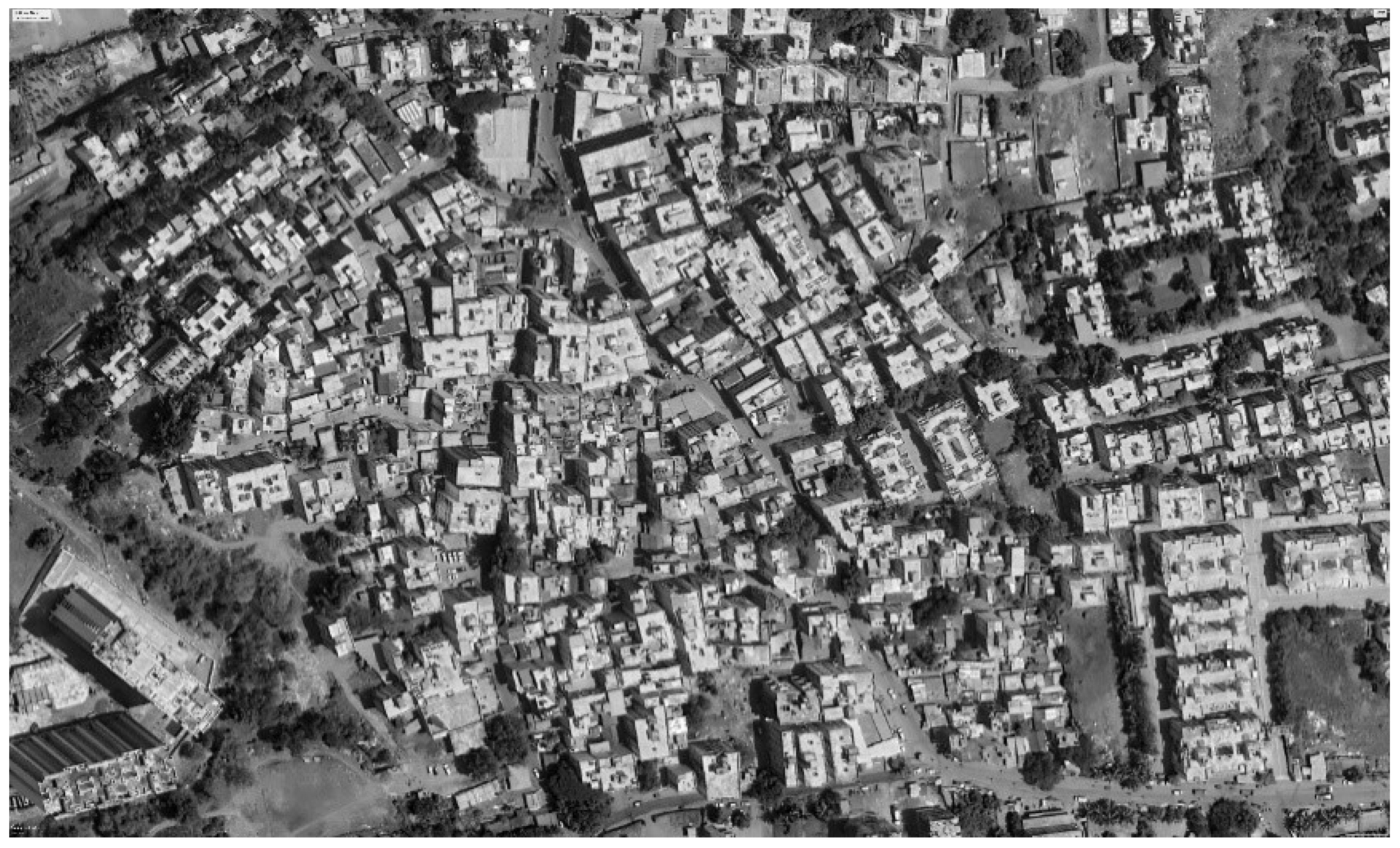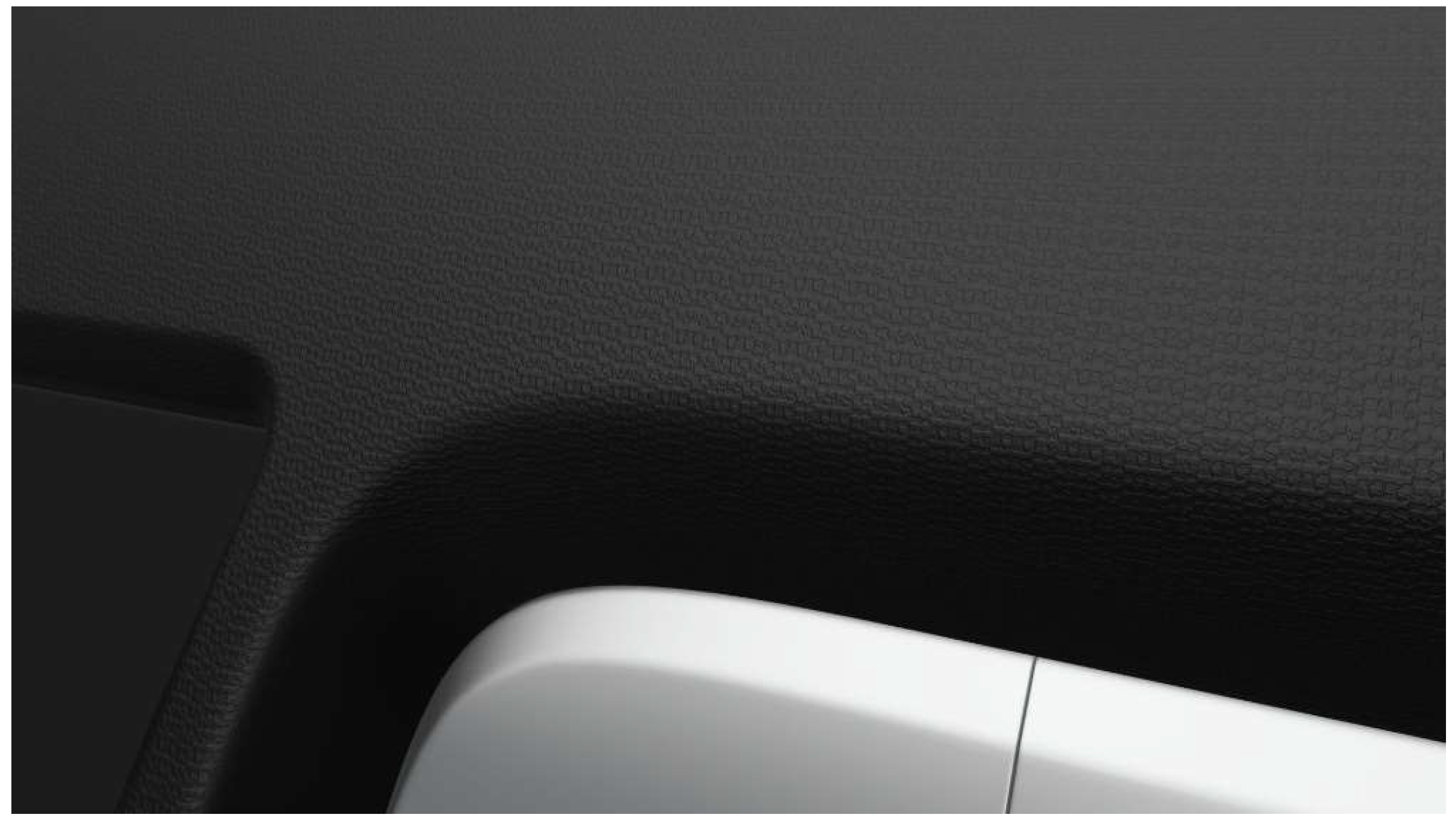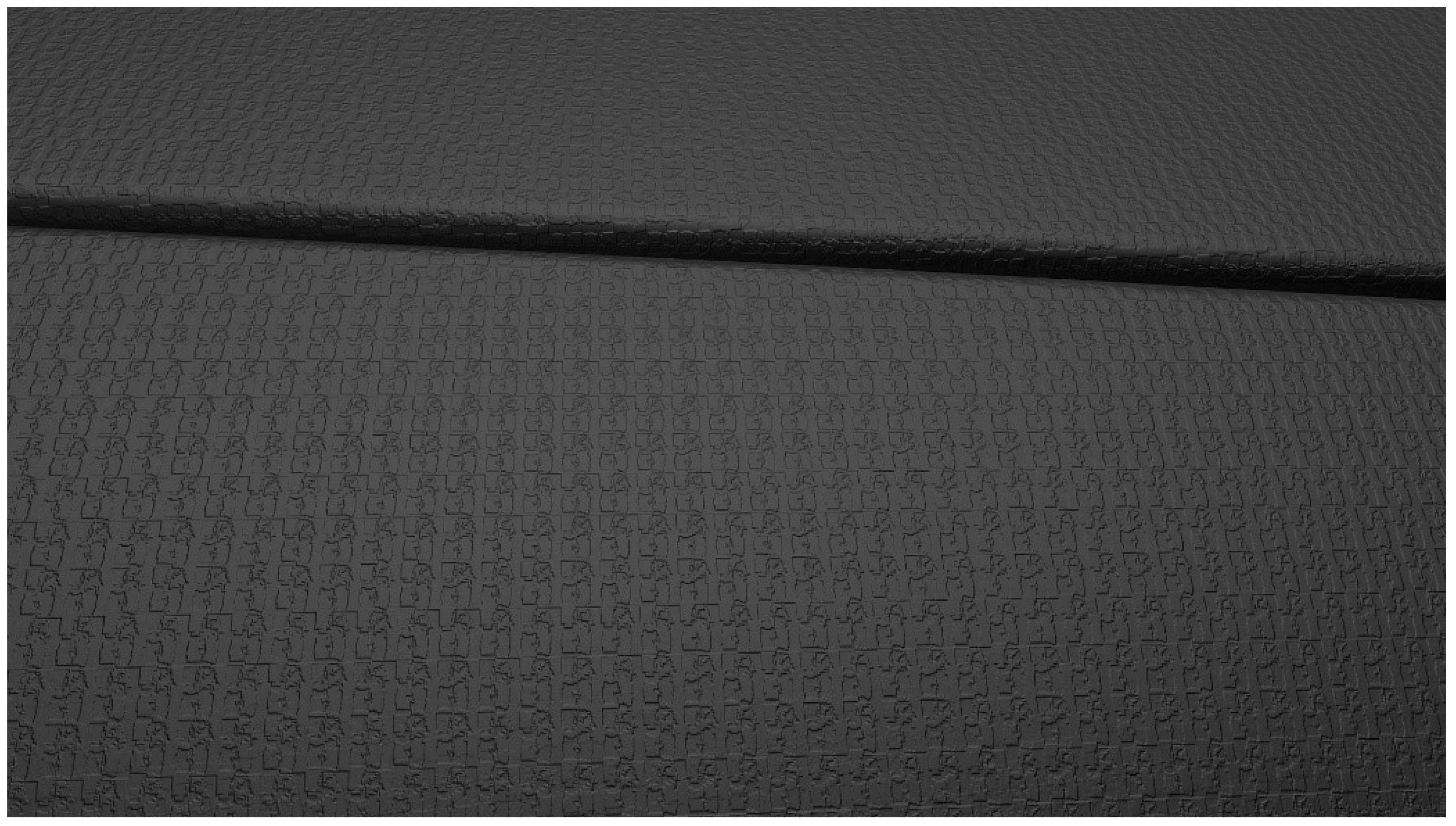Urban Inspirations: Crafting Unique Texture Patterns for Car Interiors †
Abstract
:1. Introduction
2. Literature Review
2.1. Automotive Interior Sector
2.2. Tessellation Art
2.3. Applications of Tessellations in General Objects
2.4. General Application
3. Methodology
- Open the city image in the Adobe Photoshop;
- Transform the image into black and white;
- The brightness and contrast should be adjusted to such a level that it will show a promising pattern;
- Invert the image;
- Adjust the brightness contrast once again to obtain the desired contrast in the pattern;
- Use the ‘Threshold’ filter to obtain a binary black-and-white pattern into the image;
- Adjust the brightness and contrast to obtain clarity in the image;
- Appropriately crop (a part that has the potential to generate an exciting texture) part of the large image to generate a texture pattern;
- Import it into CorelDraw (vector-based platform) to create a vector format element of the pattern;
- Generate the vector elements out of the selected pattern;
- Use the method to generate a tessellation pattern from these vector elements [14];
- Create a tile of tessellated patterns [14].
4. Conclusions
Funding
Institutional Review Board Statement
Informed Consent Statement
Data Availability Statement
Conflicts of Interest
References
- Essick, G.K.; McGlone, F.; Dancer, C.; Fabricant, D.; Ragin, Y.; Phillips, N.; Jones, T.; Guest, S. Quantitative Assessment of Pleasant Touch. Neurosci. Biobehav. Rev. 2010, 34, 192–203. [Google Scholar] [CrossRef] [PubMed]
- Sousa, E.; Sampaio, R.; Sotgiu, E.; Ribeiro, G.; Silva, C.; Vieira, J. Tactile and Visual Perception of Plastic Textures for Car Interiors: Psychophysical and Affective Dimensions. Int. J. Ind. Ergon. 2022, 92, 103369. [Google Scholar] [CrossRef]
- You, H.; Ryu, T.; Oh, K.; Yun, M.-H.; Kim, K.-J. Development of Customer Satisfaction Models for Automotive Interior Materials. Int. J. Ind. Ergon. 2006, 36, 323–330. [Google Scholar] [CrossRef]
- Bachmeier, E.E. Tessellations: An Artistic and Mathematical Look at the Work of Maurits Cornelis Escher; University of Northern Iowa: Cedar Falls, IA, USA, 2016. [Google Scholar]
- Shen, Y.; Pomeory, C.; Xi, N.; Chen, Y. Quantification and Verification of Automobile Interior Textures by a High Performance Tactile-Haptic Interface. In Proceedings of the 2006 IEEE/RSJ International Conference on Intelligent Robots and Systems, Beijing, China, 9–15 October 2006; pp. 3773–3778. [Google Scholar]
- Zaklit, J.; Wang, Y.; Shen, Y.; Xi, N. Quantitatively Characterizing Automotive Interior Surfaces Using an Optical TIR-Based Texture Sensor. In Proceedings of the 2009 IEEE International Conference on Robotics and Biomimetics (ROBIO), Guilin, China, 19–23 December 2009; pp. 1721–1726. [Google Scholar]
- Damiani, S.; Deregibus, E.; Andreone, L. Driver-Vehicle Interfaces and Interaction: Where Are They Going? Eur. Transp. Res. Rev. 2009, 1, 87–96. [Google Scholar] [CrossRef]
- Chang, W. Application of Tessellation in Architectural Geometry Design. E3S Web Conf. 2018, 38, 03015. [Google Scholar] [CrossRef]
- Liapi, K.A.; Papantoniou, A.; Nousias, C. Square Tessellation Patterns on Curved Surfaces: In Search of a Parametric Design Method. In Proceedings of the 35th International Conference on Education and Research in Computer Aided Architectural Design in Europe (eCAADe 2017), Roma, Italy, 20–22 September 2027; Volume 2, pp. 371–378. [Google Scholar]
- Cledumas, A.M.; Kamin, Y.B.; Rabiu, H. Generic Green Skills for Creativity and Innovation: Tessellation of Regular Polygons. Int. J. Eng. Adv. Technol. 2019, 8, 383–388. [Google Scholar] [CrossRef]
- Ramakrishna, H. Graphic Tools for Tessellation. Int. J. Eng. Res. Technol. (IJERT) 2019, 1, 1–5. [Google Scholar]
- Wang, P.; Zhang, M.M.; Xin, J.H.; Pan, Z.G.; Shen, H.L. An Image-Based Texture Mapping Technique for Apparel Products Exhibition and Interior Design. Displays 2003, 24, 179–186. [Google Scholar] [CrossRef]
- Reddy, V.V.; Krishna, A.V.; Sjögren, A.; Rosén, B.-G. Characterisation and Analysis of the Surface Texture of Injection-Moulded Automotive Interior ABS and PP Components. Int. J. Adv. Manuf. Technol. 2023, 128, 4579–4592. [Google Scholar] [CrossRef]
- Martin Geller Photoshop Tutorial: How Make a Tessellation Pattern. Available online: https://www.youtube.com/watch?v=x6K2wBv_bNY (accessed on 9 November 2023).
- Google Inc. Google Earth (n.d.) City 01. Available online: https://earth.google.com/web/@26.90579818,75.80279978,463.47503801a,381.57168256d,35y,-65.23035433h,0.25980958t,0.00059928r/data=OgMKATA (accessed on 10 November 2023).
- Google Inc. Google Earth (n.d.) City 02. Available online: https://earth.google.com/web/@30.73413854,76.79016423,367.15612825a,864.41172028d,35y,324.30318915h,0t,0r/data=OgMKATA (accessed on 10 November 2023).
- Google Inc. Google Earth (n.d.) City 03. Available online: https://earth.google.com/web/@23.21767683,72.62205143,-26226.81823332a,26704.58175123d,35y,-60.24620807h,2.69790077t,0r/data=OgMKATA (accessed on 10 November 2023).
- Google Inc. Google Earth (n.d.) City 04. Available online: https://earth.google.com/web/@28.58176256,77.24377113,-7664.08665801a,8950.95598422d,35y,358.3031h,0t,0r/data=OgMKATA (accessed on 10 November 2023).
- Google Inc. Google Earth (n.d.) City 05. Available online: https://earth.google.com/web/@22.70628079,75.85246069,-30680.69756478a,31138.73463994d,35y,71.26650624h,4.49645422t,0.0001r/data=OgMKATA (accessed on 10 November 2023).
- Google Inc. Google Earth (n.d.) City 06. Available online: https://earth.google.com/web/@18.51907584,73.77743567,618.61663725a,581.16685421d,35y,266.21122247h,0t,0r/data=OgMKATA (accessed on 10 November 2023).
- Avik Sinha Car Dashboard 3D Model. 2020. Available online: https://grabcad.com/ (accessed on 10 November 2023).











Disclaimer/Publisher’s Note: The statements, opinions and data contained in all publications are solely those of the individual author(s) and contributor(s) and not of MDPI and/or the editor(s). MDPI and/or the editor(s) disclaim responsibility for any injury to people or property resulting from any ideas, methods, instructions or products referred to in the content. |
© 2024 by the author. Licensee MDPI, Basel, Switzerland. This article is an open access article distributed under the terms and conditions of the Creative Commons Attribution (CC BY) license (https://creativecommons.org/licenses/by/4.0/).
Share and Cite
Halbe, P. Urban Inspirations: Crafting Unique Texture Patterns for Car Interiors. Eng. Proc. 2024, 66, 18. https://doi.org/10.3390/engproc2024066018
Halbe P. Urban Inspirations: Crafting Unique Texture Patterns for Car Interiors. Engineering Proceedings. 2024; 66(1):18. https://doi.org/10.3390/engproc2024066018
Chicago/Turabian StyleHalbe, Prasanna. 2024. "Urban Inspirations: Crafting Unique Texture Patterns for Car Interiors" Engineering Proceedings 66, no. 1: 18. https://doi.org/10.3390/engproc2024066018







